Pertussis, also known as whooping cough, is making a comeback. Learn how to keep your family safe from this vaccine-preventable disease.
The first month of your infant’s life is a vulnerable time for many reasons, but exposure to pertussis—a respiratory infection that causes a terrible cough and trouble breathing—can be an imminent danger. Because babies younger than 2 months cannot receive a pertussis vaccine, they are at particular risk for catching whooping cough. Fifty percent of infants younger than age 1 with pertussis will be hospitalized, and some of these hospitalized infants will develop permanent disabilities or die. The majority of whooping cough deaths are in babies younger than 3 months old.
Any unvaccinated adult who handles an infant can transfer the bacteria. The risk is particularly high among those living with infants—mothers, siblings and caregivers are responsible for the majority of whooping cough in very young children.
Symptoms
Early symptoms can last for 1 to 2 weeks and usually include:
- Runny or stuffed-up nose
Low fever (less than 100.4°F)
Mild, occasional cough (babies do not do this)
Apnea (life-threatening pauses in breathing) and cyanosis (turning blue or purple) in babies and young children
Later symptoms can include:
One to 2 weeks after the first symptoms start, people with whooping cough may develop paroxysms—rapid, violent, and uncontrolled coughing fits. These coughing fits usually last 1 to 6 weeks but can last for up to 10 weeks. Coughing fits generally get worse and become more common as the illness continues.
These coughing fits can cause people to:
- Make a high-pitched “whoop” sound when they are finally able to inhale at the end of a coughing fit
- Vomit during or after coughing fits
- Feel very tired after the fit, but usually seem well in-between fits
- Struggle to breathe
Herd Is the Word
The best way to protect infants is to ensure everyone around your infant is vaccinated against pertussis. This way, the baby is protected by the immunity of those around her, a concept known as herd immunity or cocooning.
Proper vaccination starts before your bundle of joy comes into the world. Pregnant women should receive a Tdap vaccine that prevents whooping cough, tetanus and diphtheria during the third trimester of pregnancy. The vaccine triggers the mother’s body to produce antibodies against whooping cough that are then passed on to her child. However, antibody production peaks after a few weeks and will not protect future pregnancies against whooping cough, so a new vaccine should be administered during each pregnancy.
The next step is for parents, grandparents, siblings and other caretakers to all be vaccinated against whooping cough. The uncontrollable, violent coughing of pertussis does not appear for more than a week after a person has been exposed to the bacteria, so even relatives and loved ones who feel fine may still be a danger to infants. If you had a pertussis vaccine more than two years ago or whooping cough in the past, you are not protected against a new infection and need to get another vaccine. It will take about two weeks after receiving your shot to be fully immunized.
Your child will receive his first pertussis vaccine when he is 2 months old, with boosters at 4 and 6 months, 15–18 months, and 4–6 years. The pertussis vaccine for children is given in one shot called DTaP. Just like the Tdap vaccine that pregnant mothers receive, DTaP protects against whooping cough, tetanus and diphtheria.
If you or a loved one has symptoms of whooping cough, don’t wait for treatment—find an urgent care location near you.
Sources:
cdc.gov, historyofvaccines.org, kidshealth.org, cdc.gov, vaccines.gov, cdc.gov
